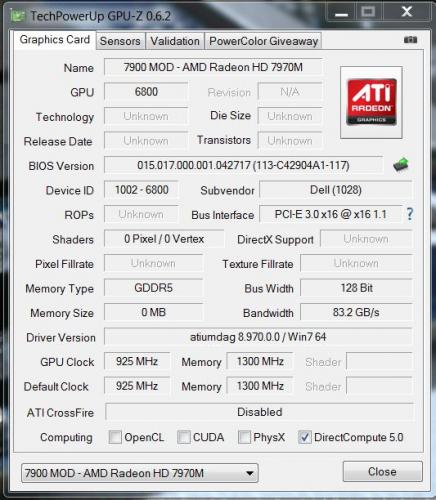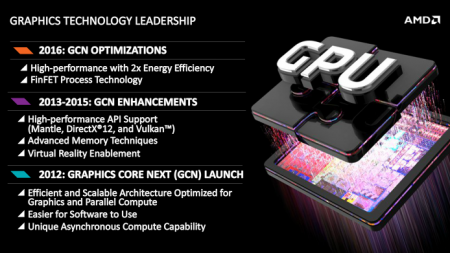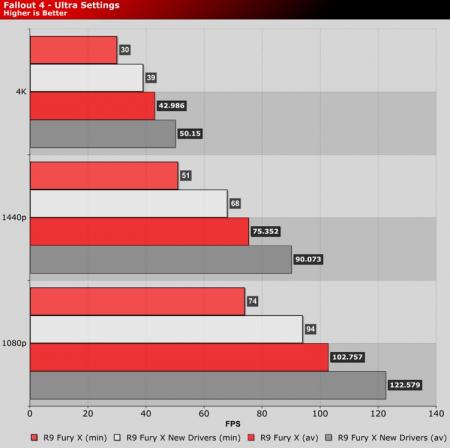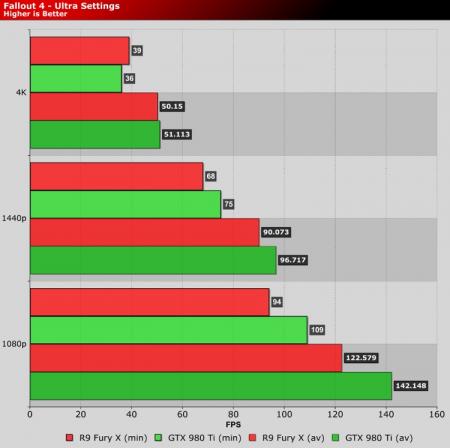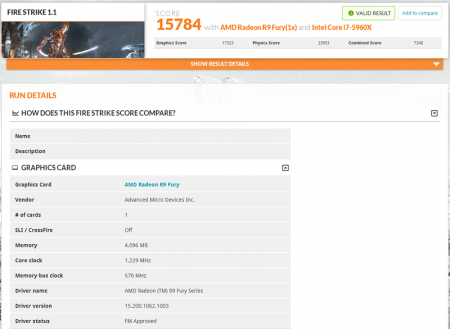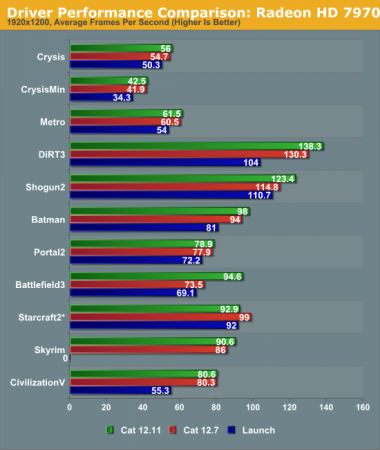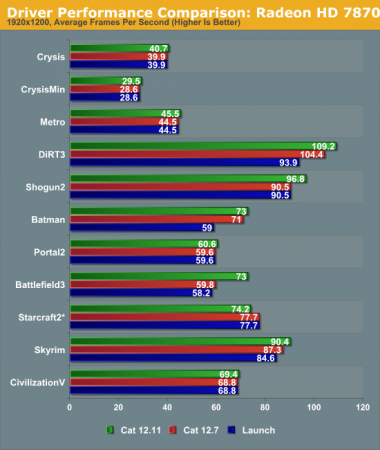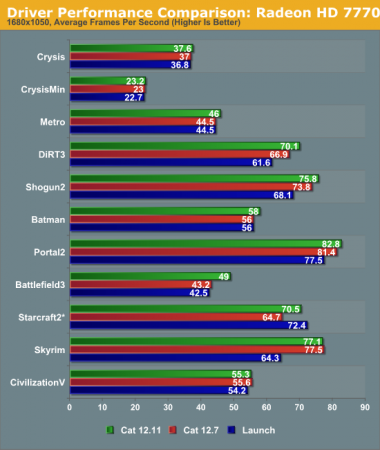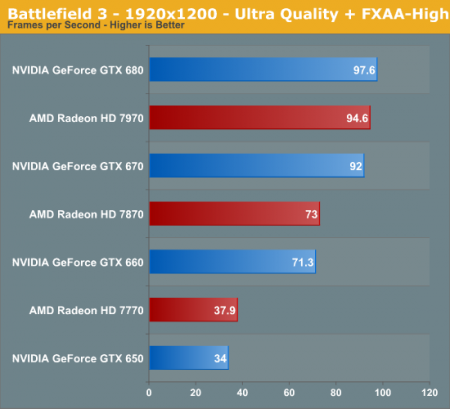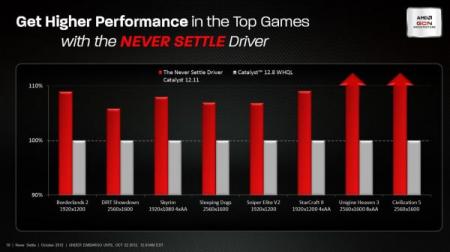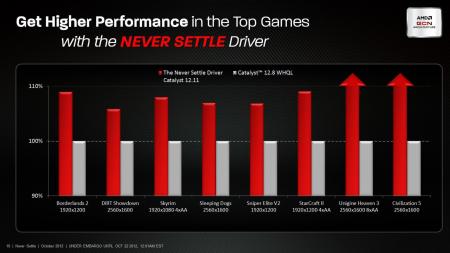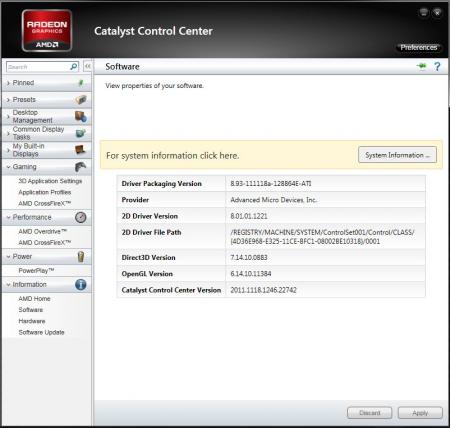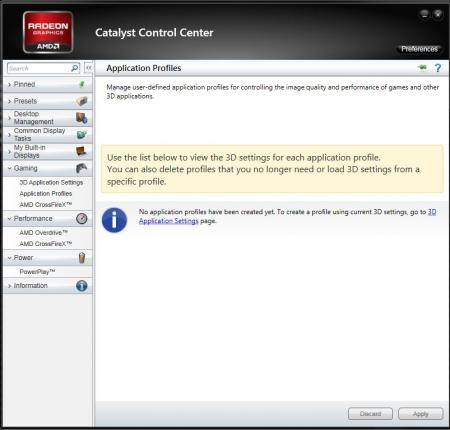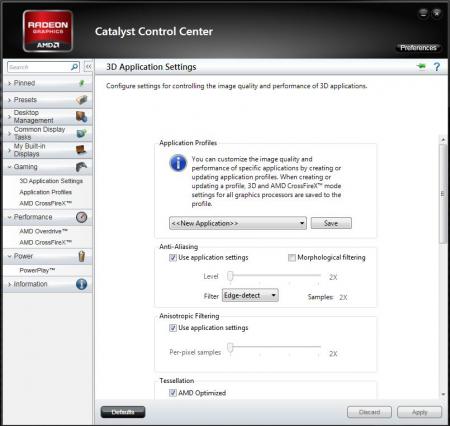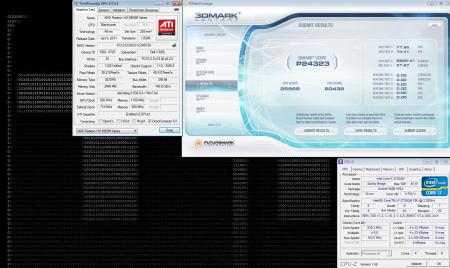Search the Community
Showing results for tags 'amd'.
-
Version 1.0.0
96 downloads
Did some tests with the VBIOS of the AMD 7970m, here's what I've got so far: - Overvolting: So far no success, when I increase the 3d voltage the card simply stays at the 2d profile. Fixed that Be aware that overvolting should only be done by experienced users and can seriously harm your GPU, shorten the life of its components and lead to unsuspected effects and / or system instability. I take no responsibility for any possible damages. Overvolting has been tested by me and @widezu69 (thanks!). It works, but can lead to instability, you need to find your limit. The M15x doesn't handle it well. I noticed similar behaviour as with my overvolted 6970m, drops in clocks, instability etc. At 1.15V even immediate crash at GPU load. The M17x R3 seems to handle it a bit better, there's probably more headroom in the voltage supply circuits which are providing the voltage for the GPU. I was able to run some vantage tests at 1Ghz with a 0.05V overvolt, my previous core clock limit was at about 950Mhz... so it definitely works. Different systems will behave in different ways, only way to find it out is to test it. Don't do it if you lack overclock experience. - Undervolting: Only did some quick tests, but it seems to work. The driver crashed all the time at clocks which normally worked fine. And at more sane clocks the card worked as expected. - Update: Yes, works very well - Core / memory clocks: Works fine so far, I only tested the 3d settings, but I assume it also works for the other clock profiles. In the GPU-Z screenshot you can see the changed clocks: There's quite a bit of work behind this, so just in case you want to buy me a beer... Here's a list of what the package contains. The names are pretty self-explanatory. "uv" for undervolt, "ov" for overvolt, clocks are "core-memory" Keep in mind that you need to rename the files before flashing due to the 8 character file name limit in DOS. Modified clocks: Dell7970m-900-1250.ROM Dell7970m-925-1300.ROM Dell7970m-940-1350.ROM Dell7970m-940-1400.ROM Dell7970m-950-1350.ROM Dell7970m-950-1400.ROM Undervolted: Dell7970m-uv-0950v.ROM Dell7970m-uv-0975v.ROM Dell7970m-uv-1000v.ROM Overvolted: Dell7970m-ov-1125v.ROM Dell7970m-ov-1150v.ROM Overvolted & modified clocks: Dell7970m-900-1300-ov1075v.ROM Dell7970m-900-1300-ov1100v.ROM Dell7970m-950-1400-ov1100v.ROM All files are based on the OEM Dell 7970m VBIOS. Instructions: For flashing refer to this guide: There's a list with the checksums of all files included in the VBIOS package, I highly recommend to check the integrity of the file before flashing it. This can easily be done with ATIflash, if you don't know how please check the guide linked above. And as always, flash on your own risk, you are responsible for your system and the changes you make on it. Feel free to ask questions, feedback is welcome as well! -
Intel's Gregory Bryant, vice president and general manager of Intel’s desktop clients platform, has gone on record during a speech at the J.P. Morgan forum saying that the company's IGP (integrated graphics processor) called Iris and Iris Pro are fast enough for casual and mainstream gamers and that they would no longer need a discrete graphics solution. That statement in itself does not sound unreasonable or outlandish as Intel IGP performance has steadily increased over the years and eaten into AMD and NVIDIA's low end share. However, Mr. Bryant also stated that Iris and Iris Pro can outperform 80% of discrete graphics chips , “We have improved graphics 30 times what they were five years ago,” but admits that Intel has done a poor job communicating the benefits of integrated graphics. According to Steam's hardware survey, as of December 2015, Intel currently holds 18.66% of the overall share with 54.61% going to NVIDIA and 26.23% to AMD. This market share is virtually unchanged from December 2014 where Intel had a share of 18.88% so it seems they do have some work to do if they want to increase their appeal to gamers. Unlike NVIDIA, AMD manufactures APUs that compete with Intel's IPG solutions but with the release of Iris 6200 pro, Intel has taken a significant lead over AMD and has even approached NVIDIA's discrete GeForce GTX 750 performance at the entry level. With AMD Zen APUs possibly being released in 2017, it may give the firm the opportunity to finally take back the low end APU performance from Intel. Source: PC World View full article
-
Well today seems to be an AMD filled news day as we also have information courtesy of HardOCP that AMD has lowered the price of it's small form factor Radeon R9 Nano from $649 to a more reasonable $499. A lot of initial apprehension about this card was because of its asking price and now with the new price drop, it has become a very compelling upgrade compared to the competition. AMD's next generation Polaris is still months away so if you're in the market for a new SFF build, the Nano is the perfect fit. View full article
-

AMD Announces New 14nmm FinFET GPU Architecture Called Polaris
Brian posted a topic in Hardware News
AMD has just e-mailed the press release (found at the end of this article) for it's new next generation 14nm FinFET GPU architecture called Polaris. In addition, AMD has produced a new video in which Raja Koduri, SVP and Chief Architect of AMD's Radeon Technology Group, and others from AMD, discuss Polaris and also give us a demonstration of it with 2x perf/watt gains vs "a comparable GPU from the competition". Earlier VideoCardz leaked some Polaris slides that are now confirmed as being accurate so we've included them here: A lot of this information isn't a big surprise to those that follow the GPU industry closely but at least now we have official confirmation from AMD. The following is their official press release: EDIT: Article corrected for errors 1/4/16 View full article -
AMD has allegedly delayed their upcoming flagship dual GPU based on the Fiji silicon dubbed "Gemini" to Q2 2016. Earlier this year, during an E3 livecast, Lisa Su (AMD CEO) had committed to a release date of Christmas 2015. When questioned by hardware.fr about the delay, AMD claims it has been pushed back because the HMD (head mounted display) ecosystem isn't quite ready yet and therefore they opted to hold off on Gemini's release until Q2 2016. However, this does bring into question whether Gemini will even be relevant in Q2 2016 as AMD is also scheduled to begin release of it's much anticipated next generation Greenland GPU during that time frame. Sources: Hardware.fr, TechPowerUP Edited for corrections. View full article
-
South Korean site etnews reports that AMD's next generation Greenland GPU, scheduled to be released in Q2 2016, will be produced by both Samsung and Global Foundries using 14 nm FinFET LPP. Since both Samsung and Global Foundries share a common IP for 14 nm LPP, AMD will be in a position to leverage both of them for maximum production capacity. TSMC, which traditionally produces GPUs for AMD and it's rival NVIDIA, lost AMD's contract due to it's inability to keep up with yield and supply demands. Greenland is expected to offer 2x the energy efficiency of the current GCN architecture and is AMD's direct competitor to NVIDIA's Pascal. Source: WCCFTech This is yet another win for Samsung which has managed to steal back Apple from TSMC and will also be producing chips for Qualcomm. It will be interesting to see whether AMD being on 14nm LPP will give it any advantage over NVIDIA who reportedly will be using TSMC's 16nm FinFET+ for Pascal. View full article
-
When Fallout 4 was first released, we saw a huge deficit between NVIDIA and AMD in performance and many attempted to blame GameWorks for AMD's performance issues with the game. Many (including myself) maintained that it was an issue with AMD drivers needing a revision to bring performance parity rather than NVIDIA or Bethesda sabotaging AMD hardware. Now ten days later we have the following results, courtesy of OC3D: I hope this serves as a lesson that when properly motivated, AMD can develop drivers that address performance deficits in DX 11 games and that it isn't always GameWorks fault.
-
Grab the new Trixx here which allows memory and core overclocking with unlocked voltage: SAPPHIRE Technology [h=4]New features[/h] New look and interface Now supports over-volting on Radeon R300 series Now supports HBM memory overclock on FURY cards Now supports over-volt on FURY cards Minimise TriXX to task bar [h=4]Main Features[/h] Overclock your AMD RADEON™ or FURY based graphics card GPU Core Clock GPU Voltage Video Card Memory Clock [*]Save your Favourite Settings with up to 4 Profiles. [*]Adjust your Graphic Card’s Fan Settings with Automatic, Fixed or Custom Fan Speeds [*]Information Tab with all you need to know about your Graphic Card including GPU, Interface, Memory, Driver Version, BIOS Version, Clocks, Shaders and more… [*]Multi-GPU support (CrossFireX) [*]Windows Sidebar Gadget option Some results that people have posted on the web:
-
Did anyone know that hd 7970m works on Asus G73jh ? 3dmark vantage: Here 3dmark 11 : here im sorry if I have posted in wrong section , I posted because M15x supports whatever g73 supports.
-
it's anyone knows some information about the next amd graphics card?
-
Hi guys, I've got an R1 M18x, and I've just swapped out two 6990m for a pair of 780m. I flashed the BIOS to unlocked A05 before I swapped and the change seemed to go well...until I tried turning it on. Screen black, and all I'm getting is two short beeps. I've taken the ram out, swapped the order etc but to no avail. Any idea what the issue could be? Thanks for any help, Mark.
-
Hello! I have a HP Pavilion g6 laptop with amd a8-3520m APU. I planning to buy a pe4h adapter with radeon hd 7750, but i dont know how the APU will respond for the egpu. Please help me!
-
Ok so I'm curious about everyone's views with regards to these two GPU manufacturers. Specifically, I'm interested in which you prefer (or if you're neutral state why). Criteria to consider: Driver quality Features Game developer support and compatiblity Hardware (reliability) Cost My pick: nVidia but they are far from perfect too. My reasons: 1. nVidia clearly has better drivers. This is especially true with SLi but even with single GPU, they have drivers that are more consistent in games and applications across the board. 2. Features: nVidia again dominates. Physx, CUDA (which I use for encoding), 3D support (will talk about this later), FXAA etc. 3. Game dev support: nVidia has their "The Way Its Mean to Be Played" game developer support program that the end user clearly benefits from with day 1 driver support from some of the latest AAA titles. This is especially true with regards to SLi profiles. 4. HW reliablity: this is where nVidia takes a hit. Traditionally, they seem to break down easier than their AMD counterpart. Furthermore, there are throttling schemes put in place via software by nVidia and ODMs like Dell for certain systems (e.g. M17x-R3 with its 78C throttle point) that make using these cards a headache at times. 5. AMD again wins most of the time with cheaper video cards and at least 80-90% of the performance of nVidia. With regards to 3D support, its currently broken for mobile systems. Whenever someone connects their nVidia card to an external monitor/TV thats 3D capable, it displays some message about the hardware being for internal testing. This is a known issue that nVidia has ignored and not addressed--definitely a poor showing. Aside from that, I think nVidia has done a stellar job with their mobility and desktop range. The performance is top notch, SLi scales perfectly and their drivers are nearly flawless.
-
Desktop, laptop whatever you got in whatever configuration, no holds barred! Mine were done with high quality selected in NVCP, I'd probably squeeze a bit more out of performance textures:
-
DOWNLOAD LINK: http://support.amd.com/us/kbarticles/Pages/AMDCatalyst1211betadriver.aspx Well AMD has finally done some nice work and created a new performance driver that does what it claims. BF3 is seeing up to 20% gains in performance and it now puts the GCN based Radeon's on par with Kepler's best (680/680M). Since we're working on an nVidia 680M SLI vs AMD 7970M Xfire article, I'll have to scrub our initial benchmark results and try out the Catalyst 12.11's instead. Good timing AMD... From Anandtech:
- 10 replies
-
- amd
- catalyst 12.11
-
(and 2 more)
Tagged with:
-
This driver is geared towards AMD's 7000 series that utilize the GCN architecture. Performance gains as high as 20% can be seen in games like Battlefield 3. Generally 7970M owners should see noticeable gains across the board! Release Highlights (click spoiler) Download Links: AMD Catalyst 12.11 Beta Driver for Windows 8, Windows 7 and Windows Vista AMD Catalyst 12.11 Beta Driver for Windows 8, Windows 7 and Windows Vista - with .NET 4.0
-
With continually dwindling marketshare and poor growth, AMD's fortunes have been taking a turn for the worst for quite awhile now. This shouldn't come as a surprise to anyone that keeps a close eye on the tech sector although what may be eye opening is the fact that this round of lay offs will include engineers. Rumor has it that the engineers to be laid off are the ones in Canada and Charlie from SA makes it seem like this is the result if mismanagement and will seal AMD's fate. Personally I think he's over sensationalizing the entire situation. Yes, AMD is in deep trouble financially because their CPU division has not been competitive for years, especially with their recent CPU architectures being utter failures compared to their Intel counterparts. However, upon closer inspection, you will notice that the engineers in Canada are not the core team of AMD engineers--those guys are located in Sunnyvale, California. The main GPU design team is also in Sunnyvale, CA. The Canadian division did have a smaller GPU + Catalyst team out there but AFAIK, the key guys were moved to California awhile back. Furthermore, AMD has been ratcheting up their AMD India development team who have been busy making SoC's and graphics chips for the company. This enables AMD to pick up engineers at a much cheaper price in a rapidly developing region (India/China/Pakistan etc). The argument that quality will suffer can't be made either because industry giants like Microsoft, Intel, IBM and others employ a huge chunk of Indian/Pakistani engineers that are on their chip development teams. So will this be a good or bad thing for AMD in the long run? In the short term, AMD is hemorrhaging market share and money and they need to consolidate quickly. This round of lay offs may be the beginning of a larger restructuring that the company desperately needs to survive. Another avenue AMD should consider is getting an ARM license like their rival nVidia has done with Tegra. While nVidia faces stiff competition from Samsung, Qualcomm and others, it isn't as intense as the 800 lb gorilla known as Intel. Intel has basically made AMD unviable in the x86 market (consumer and server) so their only way of surviving is to start focusing heavily on low power SoC for smartphones and tablets. The PC is in decline in general and AMD is very late to the party. AMD India: http://www.amd.com/in/aboutamd/Pages/aboutamd.aspx
-
So after reading endless discussions on another forum with respect to the 7970M and 680M and which is truly the better buy, I wrote the following response: This has been on my mind for quite sometime and once we rev up T|I reviews again in the future (we will likely have to hire full-time writers since admins are too busy), I plan to implement a scoring system similar to what I described above. I'd like to hear what our members think of my proposal as well as your own suggestions.
-
I came across this utility called atiman and it is similar to driver sweeper, but specifically for AMD drivers. I didn't have the opportunity to test it yet, but I will on the next catalyst release. In the meanwhile here is the link if you want to try it first Atiman Uninstaller v.7.0.2.msi
-
I was reading an article about Nvidia having better image quality than AMD for the same settings. The reason I decided to create this thread though is after reading this review and particularly that specific part and since we have forum members that have tried both cards on their laptops (ie 460M), I was wondering if you noticed the same thing.
-
For AMD Radeon HD 5000 and 6000 Series Only. Driver Release Notes LINK: http://support.amd.com/us/kbarticles/Pages/Catalyst121apreviewdriver.aspx
- 1 reply
-
- 1
-

-
- amd
- catalyst 12.1a
-
(and 1 more)
Tagged with:
-
Ok guys, these are newer than 11.11a and they will NOT cause your Alienware based system to go into an endless BSOD loop like 11.11a do. During the install process, you MIGHT encounter a bsod while the display driver is installing but upon reboot it should install successfully. After that, re-run the installer again and finish it by installing the CCC + HDMI drivers. This release includes profiles AND the ability to create your own gaming profiles! In addition, brightness controls are finally working!! Tested these in Saints Row: The Third and the performance is top notch so give them a shot and let us know what you think. For our special T|I members, we've included a download link for you hosted on our own servers: http://forum.techinferno.com/downloads.php?do=file&id=15 (file will take 30 minutes to show on our CDN). Mirror link: Deposit Files
-
Just thought I'd make note that I ordered a DV6z notebook with the following specs. I plan on pitting it up against my Sager NP8130 for build quality, screen, general use, and gaming performance. 15.6" 1080p matte LCD A8-3530mx quad core AMD CPU Radeon GT 6750m GT GPU 6GB DDR3 1333 Blu-Ray Reader / DVDRW combo drive 9-cell battery Even though I know the 6750m GPU can't hold a candle to the GTX 560m in the Sager NP8130, the HP has the advantage of 6+ hours battery life compared to 3 in the Sager, and is about $450 cheaper similarly equipped (primarily blu-ray and 1080p screen).



